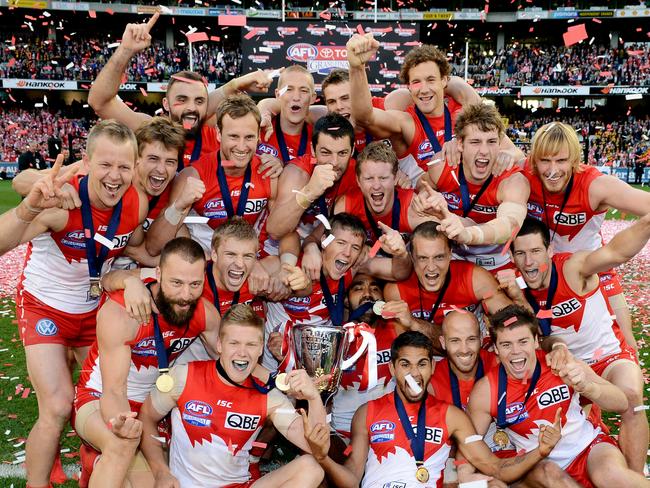AFL Finals: Mark Robinson looks at the sustained success of 21st century juggernauts Sydney, Geelong, Collingwood, Hawthorn and Brisbane
As Hawthorn eyes a spot in this year’s preliminary final, MARK ROBINSON examines what it takes to become a juggernaut and whether the Hawks have the traits to emulate Sydney and Geelong’s sustained success.
AFL
Don't miss out on the headlines from AFL. Followed categories will be added to My News.
In August, Essendon president David Barham had a question that was more envy than anything else.
Bemoaning that the Bombers could not find “long-term sustained success”, Barham asked: “Look at Sydney, look at Geelong – they can do it, so why can’t we?”
One former Cat had an answer: “If he is so keen to be like Geelong or Sydney, why doesn’t he have anyone from Geelong or Sydney there?’’
Without any doubt, Geelong and Sydney are the 21st Century juggernauts.
In the 25 seasons played since 2000, Sydney has played in 20 finals series, played 43 finals games, won 22 of them and won two flags.
Geelong has played in 19 finals series, played 47 finals matches, won a competition-best 25 finals and won four premierships.
In contrast, Carlton has played in just 15 finals matches for six wins, Essendon has played 16 finals and lost six elimination finals since its last finals win in 2004, and St Kilda has won just the one final since 2010.
The English Premier League is ridiculed for its recent dominance by the Manchester teams, Liverpool, Arsenal and Chelsea, and the AFL is leaning towards similar dominance by a handful of clubs.

Sydney, Geelong, Collingwood, Hawthorn and Brisbane have won 15 of the 24 premierships. Three others went to Richmond, which was ramshackle before the dynasty and bottom of the table this year, while West Coast has two flags and yo-yo exactly how the league is designed.
But not Sydney, nor Geelong. Just how do they do it?
And Hawthorn, too. The Hawks won their three-peat from 2013-2015, traded in new players, were in turmoil three years ago, but they stripped the list, have since rebuilt, and are now serious flag contenders.
Hawks great Dermott Brereton joked on Friday night that downtrodden Hawthorn fans have had to wait six years to have a good team again. Poor buggers. It was pure Hawks arrogance born from decades of success.
Western Bulldogs fans must wonder what the Hawks do that their club does not. Those teams, one from in the inner west and the other from the inner east, played off in the 1961 grand final. Since then, Hawthorn has won 12 premierships and the Bulldogs one.
Saints fans must also be in a fit of apoplexy. St Kilda played Hawthorn in the 1971 grand final and the Saints haven’t bothered the scorers since.


So, what is it about Hawthorn?
“I sometimes use this as a muck around what I’m about to say, but I believe it has validity and that is your club’s DNA,’’ Brereton said on Tuesday.
“You need to always have somebody at your club who has lived through the successful times and they have learnt through somebody before them from the same fraternity who has lived through their own successful times.
“With each era, you have to have somebody who has been a diving force through the successful times.
“Now (at Hawthorn) you’ve got Sam Mitchell, who has come from a successful time and he’s been able to pass on the same principles.
“His little manicure in this era is to allow the youngsters to be themselves and express themselves. But the rudiments and the fundamentals, all that goes into being a player that wears that jumper, must always hold true to the same values. That’s your DNA.”
The magnificence of Sydney and Geelong is underpinned by multiple factors.
Stability in key positions is vital.
Sydney has had Richard Colless and Andrew Pridham as presidents, Tom Harley as chief executive, Andrew Ireland as head of football and chief executive, and coaches Paul Roos and John Longmire.
Geelong was served by Frank Costa, Colin Carter and Craig Drummond as chairman, Brian Cook and Steve Hocking as chief executive, and Neil Balme, Simon Lloyd and Hocking as head of football, and Mark Thompson and Chris Scott as coaches.
It proffers the question – does stability deliver good teams, or do good teams deliver stability?
Of course, gun recruiter Stephen Wells can’t be ignored and at Sydney, there is Kinnear Beatson. Those two delivered talent, and without talent, you don’t play finals.
But you need good development to advance that talent and good coaches to utilise that talent.
Mitchell might win coach of the year, but for consistency in producing competitive teams, Longmire and Scott are the best coaches of the past decade and a half.

Then there’s culture, which is exactly what?
In a nutshell, it is good people making smart decisions. They are long-term planners and not short-term fixers.
Think Brendon Gale, Peggy O’Neal and Damien Hardwick at Richmond. And Eddie McGuire, Greg Swann and Mick Malthouse at Collingwood, and Jeff Kennett, Alastair Clarkson, and Stuart Fox at Hawthorn.
At some clubs, musical chairs are played as much as the club theme song.
There are also unknowns, such as having lifestyle advantages living outside of the Melbourne bubble – Sydney, Geelong, Brisbane – although that doesn’t hinder the Pies or Hawks.
There’s also myths, tradition and expectation.
At Hawthorn, Mitchell says the team is here to win premierships when other clubs talk about process and “sustained success”.
All the while, the Swans and Cats say nothing. They win premierships, they build on the run, they remain competitive and, in doing so, are the envy of the competition.
Still, that’s got to be irritating for long-suffering fans of other clubs.



